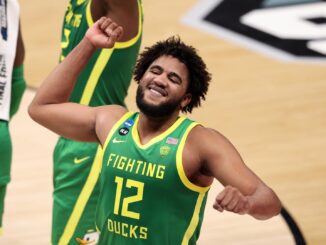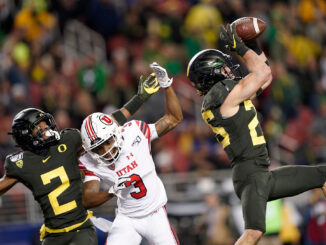
The NBA Draft is in the past, the U.S. Open came and went, and the doldrums of the never-ending MLB season have taken over the airwaves of most major sporting networks.
All of this has left me scrolling through my twitter-feed, searching desperately for something interesting to write a column about. A couple of days ago, I stumbled on something that I had repeatedly overlooked during the wild Spring months in the sporting world — another Oregon football commitment tweet.
Obviously, this is just a verbal commitment from a player that won’t take the field in Eugene until the 2018 season, but still, it was a huge get for the program. This made me think something that has probably run through many Duck fans’ minds over the past six months under the new Willie Taggart regime: Just how good is this program about to be?
I know that’s a broadly-scoped question that might not have an answer for years to come, but it is worth pondering. Here, however, I am going to branch off from that and ask something more pressing: What are reasonable expectations for the Ducks this season?
As a graduate from the University of Oregon, I could easily channel my fan-boy instincts and laud continuously the heights that this program will reach under Taggart’s leadership. But for the sake of the reader, I think it’s best to remain unbiased and anticipate the future with rational intent.
In the minds of many, the 2016 season reached near rock-bottom levels of awful for the Ducks. They went 4-8 on the year, and finished sixth in the Pac-12 with a 2-7 conference record. For the first time since 2004, they did not qualify for a bowl game, and losses to both Washington and Oregon State snapped win-streaks that lasted 12 and 8 years, respectively.
The horrifically bad season started with memories of a 47-41 triple-overtime loss to TCU in the Alamo Bowl, a game in which the Ducks gave up 31-unanswered points in the second half. It ended with the firing of head coach Mark Helfrich.
So, there’s nowhere to go but up, right?
Many Duck fans, like myself, hope that is the case as we gear up for the “Taggart Era” of Oregon football. On December 7th, the program was infused with energy (or Pepsi Cola if you ask Jim Leavitt). Since then, the Ducks pieced together the No. 19 recruiting class in the nation, including five four-star athletes. Not bad for a school that is infamously difficult to recruit to.
What is hard to determine, though, is whether or not that young group of talent will make an immediate impact on the field. But in either case, the Ducks return a fair number of starters on both sides of the ball.
On offense, Oregon will have eight returning starters, the second most of any Pac-12 team. More importantly, they haven’t lost more than one starter out of any given position group.
Quarterback Justin Herbert, who eventually won the job as a true freshman last season, has been given the reins to a potentially high-powered offense. Royce Freeman, a surprise returner for the Ducks, will be taking advantage of his final season of eligibility and joining well-polished running backs Tony Brooks-James and Kani Benoit in the backfield.
This “three-headed monster” will be complemented by Darren Carrington and Charles Nelson at the receiver position, both of whom are seniors. Sophomore Dillon Mitchell also got some experience in his freshman year, and he should be able to build on the impressive performance he put on in Oregon’s spring game in 2016.
On the defensive side of the ball, senior Henry Mondeaux and junior Jalen Jelks will hold down the edges of an experienced line, and sophomore Troy Dye will find his way into numerous backfields after a standout freshman season.
The defensive secondary is littered with familiar faces, including seniors Arrion Springs and Tyree Robinson, and junior Khalil Oliver will be working alongside sophomore Brenden Schooler, who finished the season with a team-high four interceptions last year.
When you boil this all down, you get a fairly experienced team that has been through some rough times together. The 2017 schedule has some obstacles, including a home-stand vs. Nebraska in week 2, as well as road games at Stanford, UCLA and Washington.
It is tough to calibrate the levels of motivation under the new coaching staff, but if social media is any indication, the team seems to be heading in the right direction and a new air of confidence has been felt around the locker room.
It seems unfair that the upcoming season should be seen as a failure should Oregon not be in contention for the College Football Playoff in Taggart’s inaugural season in Eugene, but I don’t see any reason why they can’t go 8-5 or 9-4 and find themselves competing for a bowl game come December.
A win at home vs. Nebraska early in the season would set the tone. A 2-2 split vs. Stanford, UCLA, Utah and Washington will be exceeding expectations, and a dismantling of Oregon State will restore proper levels of sanity in Duck fans everywhere.
No matter what the win-loss column says at the end of the season, one thing is for sure:
The Oregon Ducks will have a great season, if they want to.




Based on talent alone the Ducks were not a 4-8 team last year. The wheels clearly came off as there were more problems than we can care to name. Horrible decision led to the NE loss. Several other games were well within our grasp.
In a short amount of time Taggart and crew have changed recruiting. It stands to reason we should see pretty immediate improvement. The offense will be back. Big question is can Leavitt get our D in a place where we can win some of those games. If Pagano and Scott sure up the D and Pickett and Lenoir either start or push Arrion and Ugo to play up to their potential that D can make a good swing. (not saying they’ll be a top 10 D, just hopefully not look like swiss cheese)
I’m optimistic. Thinking 9-10 wins. If we can beat NE early in the season I think we see buy in quickly and play above expectations and get 10+ wins. If the NE game is close and we lose one maybe we end 8-4 ish.
Looking forward to a new start.